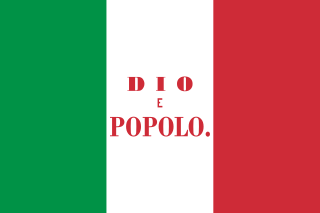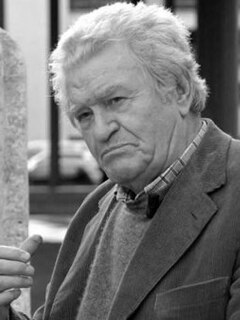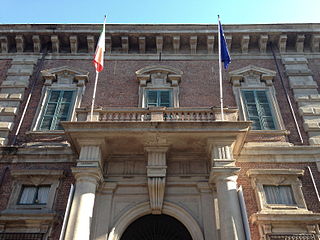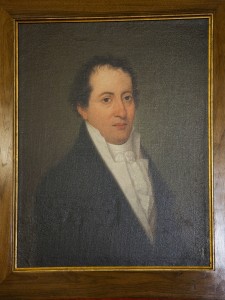Related Research Articles

Goffredo Mameli was an Italian patriot, poet, writer and a notable figure in the Risorgimento. He is also the author of the lyrics of "Il Canto degli Italiani", the national anthem of Italy.

EUR is a residential and business district in Rome, Italy, part of the Municipio IX.

The Roman Republic was a short-lived state declared on 9 February 1849, when the government of the Papal States was temporarily replaced by a republican government due to Pope Pius IX's departure to Gaeta. The republic was led by Carlo Armellini, Giuseppe Mazzini, and Aurelio Saffi. Together they formed a triumvirate, a reflection of a form of government in the ancient Roman Republic.

Pietro Cascella was an Italian sculptor. His principal work consisted of large monumental sculptures, including the International Monument to the Victims of Fascism in the Auschwitz II-Birkenau death camp in Poland (1957–1967), and an underground mausoleum for Silvio Berlusconi at his villa in Arcore in the 1980s.

The Roman Republic was a sister republic of the First French Republic. It was proclaimed on 15 February 1798 after Louis-Alexandre Berthier, a general of Napoleon, had occupied the city of Rome on 10 February. It was led by a Directory of five men and comprised territory conquered from the Papal States. Pope Pius VI was exiled to France and died there in August 1799. The republic immediately took control of the other two former-papal revolutionary administrations, the Tiberina Republic and the Anconine Republic. The Roman Republic proved short-lived, as Neapolitan troops restored the Papal States in October 1799.
Giovanni Becatti was an Italian Classical art historian and archaeologist.
Mario Torelli was an Italian scholar of Italic archaeology and the culture of the Etruscans. He taught at the University of Perugia.

Palazzo Brera or Palazzo di Brera is a monumental palace in Milan, in Lombardy in northern Italy. It was a Jesuit college for two hundred years. It now houses several cultural institutions including the Accademia di Brera, the art academy of the city, and its gallery, the Pinacoteca di Brera; the Orto Botanico di Brera, a botanical garden; an observatory, the Osservatorio Astronomico di Brera; the Istituto Lombardo Accademia di Scienze e Lettere, a learned society; and an important library, the Biblioteca di Brera.
The culture of music in Rome is intensely active. The venues for live music include:

The Gazzetta Ufficiale della Repubblica Italiana is the official journal of record of the Italian government. It is published by the Istituto Poligrafico e Zecca dello Stato in Rome.
Guglielmo Janni, was an Italian painter belonging to the modern movement of the Scuola romana .

Enrico Coleman was an Italian painter of British nationality. He was the son of the English painter Charles Coleman and brother of the less well-known Italian painter Francesco Coleman. He painted, in oils and in watercolours, the landscapes of the Campagna Romana and the Agro Pontino; he was a collector, grower and painter of orchids. Because of his supposedly Oriental air, he was known to his friends as "Il Birmano", the Burmese.
Nikola Prsendic is a contemporary artist and painter, currently based in Belgrade, Serbia.

The national colours of Italy are green, white, and red, collectively known in Italian as il Tricolore. The three Italian national colours appeared for the first time in Genoa on 21 August 1789 on the cockade of Italy shortly after the outbreak of the French Revolution, on 11 October 1796 they were used for the first time in Milan on a military banner, while on 7 January 1797 in Reggio Emilia they appeared for the first time on a flag.

Guillaume-Charles Faipoult was a French aristocrat, soldier and politician who was Minister of Finance during the French Revolution. He then represented France in Italy, where he organized the newly formed republics. During the First French Empire he was prefect of the Scheldt department, and then Minister of Finance in Spain under Joseph Bonaparte. Faipoult was prefect of Saône-et-Loire during the Hundred Days.
Pasquale Verrusio was an Italian painter, sculptor and engraver.
The Istituto Lombardo Accademia di Scienze e Lettere is an Italian academy founded by Napoleon in 1797. At the time of the foundation the Istituto was an institution of the Cisalpine Republic and its name was Istituto Nazionale della Repubblica Cisalpina.
Filippo Maria Renazzi (1745-1808) was an Italian Jurist and historian active in the Papal States of the eighteen century. During his life he was a well known scholar of criminal law, and nowadays he is mainly remembered for his history of the University of Rome.

Vittorio Barzoni was an Italian author, mainly of anti-Napoleonic tracts during the French occupation of Northern Italy.

Studio fotografico Vasari it is one of the oldest Italian companies operating in the field of photography.
References
- ↑ Pepe, Luigi (1996). "L'Istituto nazionale della Repubblica romana" (in Italian). Persée. Retrieved 28 July 2013.
- ↑ Susan Vandiver Nicassio (1999). "Ten Things You Didn't Know About Tosca" . Retrieved 29 July 2013.